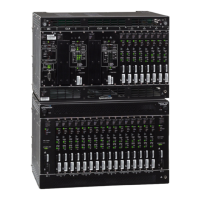1
097-55501-01 Issue 6 – June 2003 23
2
5
3
Description
signals. D4 (also known as SF) DS1 signals are not capable of transporting
SSM.
The relationship between SSM quality level and the meaning attached to
each level is listed in Table 1-1.
1.3.4.1 Input SSM
The TimeHub 5500 provides several input-related SSM capabilities.
Foremost is the ability to extract and report the encoded SSM value on any
of the timing inputs. The TL1 keyword CURRSSM provides this capability.
For detailed syntax, see the description of this keyword in the TL1 Reference
Manual. It provides the capability to select any of the inputs and retrieve the
SSM value currently associated with that particular input. The value
returned is the Quality Level in Table 1-1. There are several considerations
that need to be understood when using CURRSSM:
• Some types of inputs are not capable of providing SSM information
(for example, D4 framed DS1 and 5/10 MHz inputs). However, it is
necessary to allow such inputs to have an associated SSM value to
support SSM-based selection of the input to use as the active
timing reference. Otherwise, if only ESF signals with valid SSM
information were allowed, the non-SSM carrying inputs could
never become the active reference when the synchronization mode
is set to SSM (see SYNCMDE description below). The QLEVEL
keyword provides this capability. Using QLEVEL, an assumed SSM
Table 1-1. SSM Quality Level and Meaning
Description Quality Level Abbreviation
Stratum 1 Traceable 1 PRS
Synchronized - Traceability Unknown 2 STU
Stratum 2 Traceable 3 ST2
Transit Node Traceable 4 TNC
Stratum 3E Traceable 5 ST3E
Stratum 3 Traceable 6 ST3
SONET Minimum Clock Traceable (20 ppm clock) 7 SMC
Stratum 4 Traceable 8 ST4
DON’T USE for synchronization 9 DUS
Reserved 10 RES

